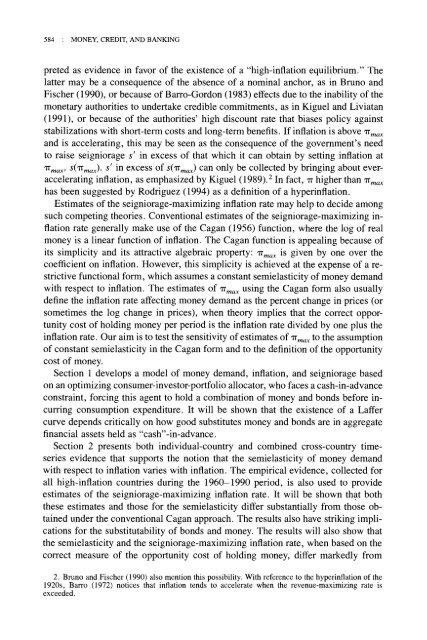Money Demand and Seigniorage-Maximizing ... - William Easterly
Money Demand and Seigniorage-Maximizing ... - William Easterly
Money Demand and Seigniorage-Maximizing ... - William Easterly
You also want an ePaper? Increase the reach of your titles
YUMPU automatically turns print PDFs into web optimized ePapers that Google loves.
584 : MONEY, CREDIT, AND BANKING<br />
preted as evidence in favor of the existence of a "high-inflation equilibrium." The<br />
latter may be a consequence of the absence of a nominal anchor, as in Bruno <strong>and</strong><br />
Fischer (1990), or because of Barro-Gordon (1983) effects due to the inability of the<br />
monetary authorities to undertake credible commitments, as in Kiguel <strong>and</strong> Liviatan<br />
(1991), or because of the authorities' high discount rate that biases policy against<br />
stabilizations with short-term costs <strong>and</strong> long-term benefits. If inflation is above SmaX<br />
<strong>and</strong> is accelerating, this may be seen as the consequence of the government's need<br />
to raise seigniorage s' in excess of that which it can obtain by setting inflation at<br />
Smax S(XmaX) 51 in excess °f S(XmaX) can only be collected by bringing about everaccelerating<br />
inflation, as emphasized by Kiguel (1989).2 In fact, 1T higher than SmaX<br />
has been suggested by Rodriguez (1994) as a definition of a hyperinflation.<br />
Estimates of the seigniorage-maximizing inflation rate may help to decide among<br />
such competing theories. Conventional estimates of the seigniorage-maximizing inflation<br />
rate generally make use of the Cagan (1956) function, where the log of real<br />
money is a linear function of inflation. The Cagan function is appealing because of<br />
its simplicity <strong>and</strong> its attractive algebraic property: SmaX is given by one over the<br />
coefficient on inflation. However, this simplicity is achieved at the expense of a restrictive<br />
functional form, which assumes a constant semielasticity of money dem<strong>and</strong><br />
with respect to inflation. The estimates of SmaX using the Cagan form also usually<br />
define the inflation rate affecting money dem<strong>and</strong> as the percent change in prices (or<br />
sometimes the log change in prices), when theory implies that the correct opportunity<br />
cost of holding money per period is the inflation rate divided by one plus the<br />
inflation rate. Our aim is to test the sensitivity of estimates °f SmaX to the assumption<br />
of constant semielasticity in the Cagan form <strong>and</strong> to the definition of the opportunity<br />
cost of money.<br />
Section 1 develops a model of money dem<strong>and</strong>, inflation, <strong>and</strong> seigniorage based<br />
on an optimizing consumer-investor-portfolio allocator, who faces a cash-in-advance<br />
constraint, forcing this agent to hold a combination of money <strong>and</strong> bonds before incurring<br />
consumption expenditure. It will be shown that the existence of a Laffer<br />
curve depends critically on how good substitutes money <strong>and</strong> bonds are in aggregate<br />
financial assets held as "cash"-in-advance.<br />
Section 2 presents both individual-country <strong>and</strong> combined cross-country timeseries<br />
evidence that supports the notion that the semielasticity of money dem<strong>and</strong><br />
with respect to inflation varies with inflation. The empirical evidence, collected for<br />
all high-inflation countries during the 1960-1990 period, is also used to provide<br />
estimates of the seigniorage-maximizing inflation rate. It will be shown that both<br />
these estimates <strong>and</strong> those for the semielasticity differ substantially from those obtained<br />
under the conventional Cagan approach. The results also have striking implications<br />
for the substitutability of bonds <strong>and</strong> money. The results will also show that<br />
the semielasticity <strong>and</strong> the seigniorage-maximizing inflation rate, when based on the<br />
correct measure of the opportunity cost of holding money, difter markedly from<br />
2. Bruno <strong>and</strong> Fischer (1990) also mention this possibility. With reference to the hyperinflation<br />
of the<br />
1920s, Barro (1972) notices that inflation tends to accelerate when the revenue-maximizing rate is<br />
exceeded.


